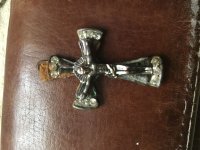49er12
Bronze Member
- Aug 22, 2013
- 1,238
- 1,630
- Detector(s) used
- Minelab xterra, Whites DFX, Notka Makro Simplex. Folks the price don’t mean everything, the question is are you willing to put in the time to learn the machine, experience will pay off I guarantee it.
- Primary Interest:
- All Treasure Hunting
I ask this because recently I’ve found 2 necklace pendants, no chain. What’s obvious is the stones are seemingly glass, not diamonds, did early settlers use glass for stones. Was the purpose using glass because diamonds where to expensive or frankly where not common use at time, yes I’ve found broaches, pendants but can anyone offer explanation, thanks


Amazon Forum Fav 👍
Last edited:




